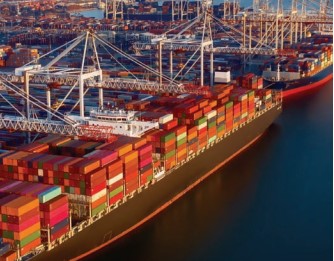The oversupply of containers is contributing to second-hand container market prices plummeting. Container xChange shared in a recent analysis.
The current situation of oversupply of containers is a result of a series of reactionary market disruptions that began soon after the outbreak of the pandemic in early 2020. With the rise in demand, congestion at ports increased and the container capacity was held up for a considerably long period. This led to the panic ordering of new boxes at record levels. With time, as markets reopen and demand softens, the oversupply is a natural outcome of demand-supply forces balancing at new levels,” says Christian Roeloffs, Co-founder and CEO of Container xChange, a tech platform that simplifies the logistics of container movement. “The oversupply situation does not come as a surprise because the average container prices and leasing rates have been declining globally since September October 2021,” he adds.
Freight rates have come down by an average of 20 percent since the beginning of 2022 and these will continue to slide gradually, but there will not be a massive decrease because the underlying disruptions in the supply chain are still there. With inflation and pandemic-induced lockdowns, disruptions will continue to change the equation between supply, demand, and prices. In the longer term, these will phase out and create a new normal balance of supply and demand.
Fresh data published by Drewry indicates an excess of six million TUEs of capacity in the global fleet of containers. The Container xChange analysis further states that the oversupply will obviously lead to the requirement for more depot space, which is already scarce. And, in a scenario where we assume that the global supply chain disruptions will fade away with time, there will be higher box productivity and we will need fewer boxes per unit of cargo. There is a high possibility of a scenario where the equipment capacity will not get soaked. “Carriers will rush to get rid of their older equipment, second-hand container prices will continue to slide gradually only to reach a new normal level and the new market will dry up,” says Roeloffs.
The situation can be studied from the perspective of the market forces of demand and supply. If the demand for containers falls, then the supply of containers will naturally increase. Also, price is a function of demand and supply. If demand falls and supply increases, prices will fall. And that is what is currently happening with the container prices.
The shape of the peak season
We’ve said before that the main factor that has driven up prices much more than the historical levels has been a supply-side crunch over the past two years because of lengthening turnaround times of containers caused by supply chain congestions. That still holds true. We still have about 10 percent of transport capacity tied up and removed from the value chain. Demand, on the other hand, has softened now.
US imports decreased by 2.4 percent between March and April. Purchases of goods went down US$0.1 billion as higher imports of industrial supplies and materials (up 1.8 billion) were offset by lower imports of consumer goods (down 1.5 billion), according to the US Census Bureau. In the long run, ocean freight demand is forecast as a multiplier of global GDP growth. And if global GDP doesn’t plummet by, for instance, 5 percent, the global demand for shipping capacity will not significantly plummet.
“To sum up, we foresee a significant rise in the pent-up, peak season demand. This will likely keep container prices potentially stable in the short term as we inch closer to the peak season. What remains to be seen is how the geopolitical circumstances and the pandemic-induced lockdowns play out in the coming months,” concludes Roeloffs.

.jpg)


